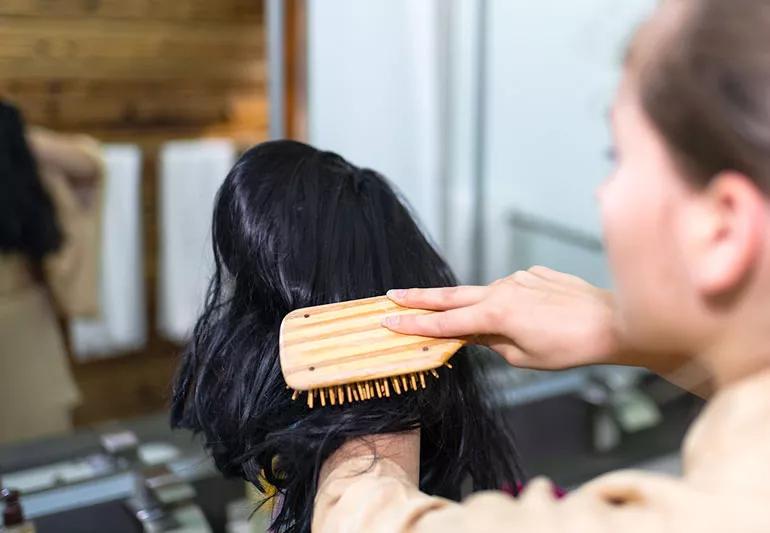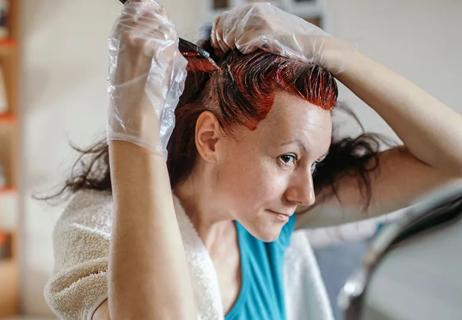Wearing a wig could help you feel more comfortable and less self-conscious

If you’re experiencing a medical condition like alopecia areata or going through treatment like chemotherapy for cancer, you might be dealing with the loss of your natural hair. And while some people don’t mind rocking the bald look, others decide that a wig is the best move for their comfort and self-esteem.
Advertisement
Cleveland Clinic is a non-profit academic medical center. Advertising on our site helps support our mission. We do not endorse non-Cleveland Clinic products or services. Policy
Long-wearing, high-quality wigs are an investment. Aesthetic specialist Michele Taylor shares tips to help you to choose, style and care for yours.
Buying a wig is a bit like buying a new outfit: You want to be sure fits right and looks good on you — and more importantly, that you feel great wearing it.
“Make sure your new wig will fit well by measuring your head with your hair lying flat against your head,” Taylor advises, “and make sure you know how to adjust the wig’s size, if needed.”
Of course, you’ll also want to consider the color. You may feel more comfortable wearing a wig that’s close to your natural hair color, or you may want to embrace the opportunity to try out new colors and styles.
As you’re comparing wig quality, you’ll find that there are many different options, including synthetic wigs, human hair wigs and wigs that are a combination of the two. “Each kind of wig has pros and cons and varies in price,” Taylor says. “The most important thing is to find a wig you like that also meets your needs.”
Here are a few factors to consider:
Advertisement
“You want to feel comfortable in your wig,” Taylor says, “so knowing how to put it on so that it fits and stays in place will go a long way.”
Follow these steps to put on your wig:
Using accessories like wig caps (liners) or wig headbands (wig huggers) can help your wig fit more comfortably. And don’t worry if some hair doesn’t lay in place. “Having a little bit of hair out of place will make your wig look more natural,” Taylor says.
Even wigs made from natural hair are not your natural hair, so they need to be handled carefully. It’s important to follow your wig manufacturer’s suggestions for taking care of your wig, but there are some rules of general care that can help keep it in tip-top shape.
Style your wig using your fingers, when possible, and if you do use a brush and comb, use only those designed for wigs. Use styling products sparingly, as the more hairspray or gel you use, the more often you’ll need to wash your wig (or have it cleaned).
“If you want to change your wig’s look, consider working with a professional hairstylist,” Taylor advises.
Whether you’ve chosen a natural human hair wig or a synthetic wig, you’ll need to clean it regularly with specially designed shampoo and conditioner.
“Wash your synthetic wig at least once a month and more frequently if you wear it every day,” Taylor says.
The process of washing a natural human hair wig isn’t actually all that different from the process of washing naturally growing hair. It just doesn’t happen in the shower!
Advertisement
Once your natural human hair wig is dry, you can style it with a curling iron set on low.
An important tip before you begin: “Remember that you can’t use heat to dry or style a synthetic hair wig,” Taylor says. “So, if you wear a synthetic hair wig, build in time for it to dry after washing.”
Once your wig is dry, spray it with a detangler or hair sheen product, combing the product through the fibers. You can style your wig with brush rollers or your fingers while it’s still damp. Sometimes, you can style a synthetic hair wig by gently shaking it, too.
Advertisement
If you’ve lost your hair due to serious illness, you’re likely facing lots of life-altering decisions that might seem much more important than picking out and caring for a wig. But if you have a serious illness, you may sometimes feel as if your life choices are being made by events you can’t control.
“Being able to choose a wig won’t make up for those lost choices,” Taylor says, “but it’s still a choice that you get to make, which can be meaningful during a time when you can’t control so much of what’s happening to you.”
Advertisement
Learn more about our editorial process.
Advertisement

Focus on nutrition, gentle styling habits and adapting to your hair type

Eating whole grains, salmon, fruits and vegetables can help you achieve longer, healthier locks

Your genes, ethnicity, diet and stress levels may all affect your facial hair

Prepping the area, exfoliating beforehand and communicating with your esthetician will help give you the best (and least painful) results

Pumpkin seed oil supplements may help with hair loss, but they may not be right for everyone

While there’s little risk in trying this hair care treatment, there isn’t much science to back up the claims

Research shows some associations and concerns, but no definitive connections

Study results don’t conclude hair straighteners cause cancer, but they do raise questions

If you’re feeling short of breath, sleep can be tough — propping yourself up or sleeping on your side may help

If you fear the unknown or find yourself needing reassurance often, you may identify with this attachment style

If you’re looking to boost your gut health, it’s better to get fiber from whole foods